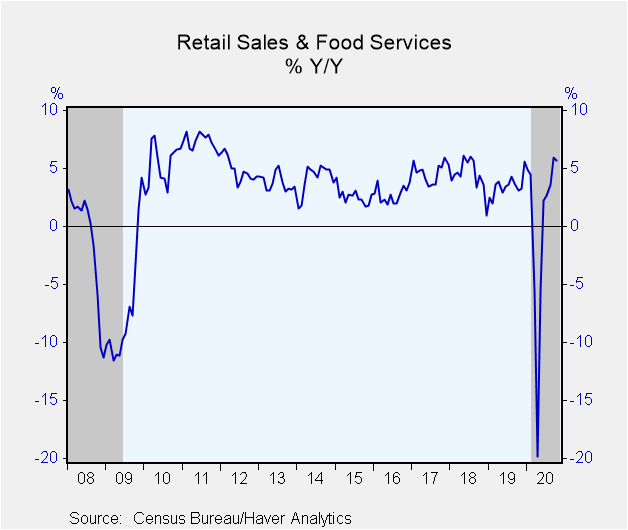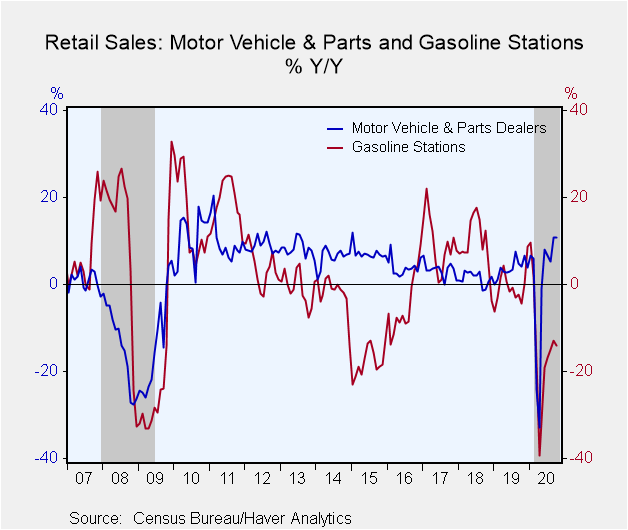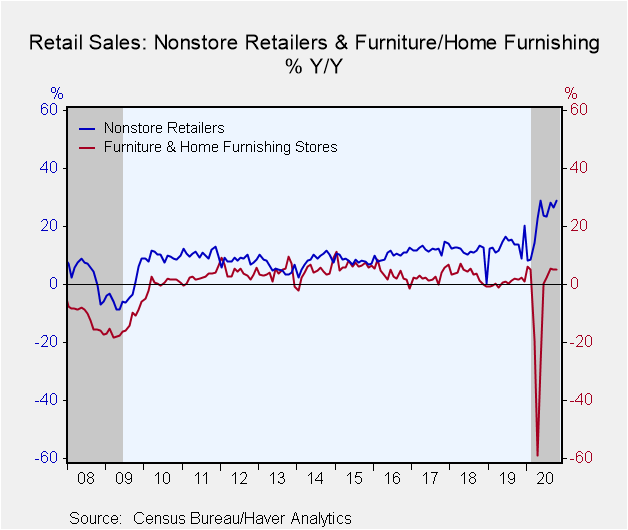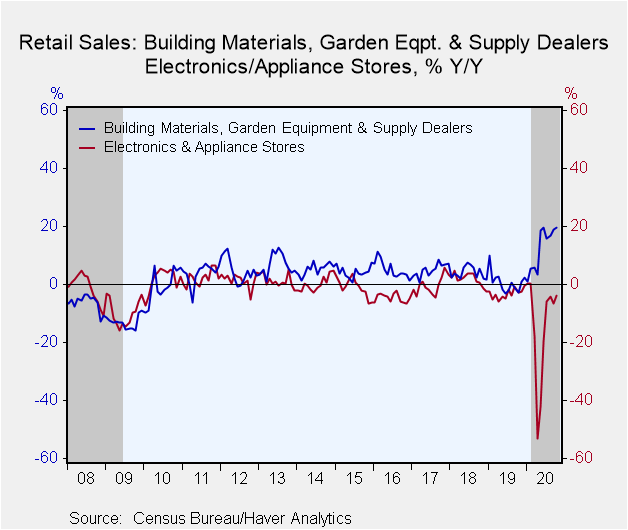 Global| Nov 17 2020
Global| Nov 17 2020U.S. Retail Sales Gain Disappoints in October
by:Tom Moeller
|in:Economy in Brief
Summary
• Consumers barely lift spending following five months of strong increases. • Spending slowdown widens. As the number of coronavirus cases increased, total retail sales including food service & drinking establishments improved just [...]
• Consumers barely lift spending following five months of strong increases.
• Spending slowdown widens.
As the number of coronavirus cases increased, total retail sales including food service & drinking establishments improved just 0.3% (5.7% y/y) during October following a 1.6% September increase, revised from 1.9%. August sales strengthened 1.4%, revised from 0.6%. A 0.4% October increase had been expected in the Action Economics Forecast Survey. Retail sales excluding motor vehicles & parts edged 0.2% higher (4.4% y/y) after improving 1.2% in September, revised from 1.5%. Sales during August gained 1.5%, revised from 0.5%. A 0.6% gain had been anticipated. In the retail control group, which excludes autos, gas stations, building materials & food services, retail sales edged 0.1% higher (9.6% y/y) following three straight monthly increases of roughly 1.0%. Retail sales excluding restaurants rose 0.3% last month (8.5% y/y) after improving 1.5% in September.
Sales of motor vehicle & parts dealerships in October rose 0.4% (10.7% y/y). That compared to a 0.8% slip in unit vehicle sales reported earlier this month. The gain followed a 2.9% rise in September which came after a 1.1% August improvement. Gasoline & service station sales rose 0.4% (-14.0% y/y), even though seasonally adjusted gas prices (constructed by Haver Analytics) rose 1.1% m/m. As individuals stayed home due to the coronavirus outbreak, building materials & garden store sales firmed 0.9% (19.5% y/y) after improving 4.4% in September.
That inclination to stay home caused sales on nonstore retailers to jump 3.1% (29.1% y/y) and make up a 1.7% September decline. Electronics & appliance store sales also benefited, jumping 1.2% (-3.9% y/y) and recovering September's 1.1% shortfall. Working the other way, apparel & accessory store sales weakened 4.2% (-12.6% y/y) after surging for five consecutive months. Sporting goods, hobby, book & music store sales also fell 4.2% (+12.4% y/y) following an 8.0% increase. General merchandise stores sales fell 1.1% (+2.5% y/y) after rising 1.7% in September. Shopping in department store sales continued to be shunned as sales fell 4.6% (-11.9% y/y) after September's 9.4% strengthening. Furniture & home furnishing store sales edged 0.4% lower (+5.2% y/y) following a 0.6% improvement.
Grocery & beverage store sales eased 0.2% last month (+10.3% y/y) and reversed September's fall. In another nondiscretionary category, health & personal care products sales edged 0.1% lower (+3.8% y/y) after increasing 1.3%.
Eating out became less frequent as restaurant and drinking establishment sales slipped 0.1% last month (-14.2% y/y) after strengthening for five straight months.
The retail sales data can be found in Haver's USECON database. The Action Economics forecast is in the AS1REPNA database.
| Retail Spending (% chg) | Oct | Sep | Aug | Oct Y/Y | 2019 | 2018 | 2017 |
|---|---|---|---|---|---|---|---|
| Total Retail Sales & Food Services | 0.3 | 1.6 | 1.4 | 5.7 | 3.5 | 4.4 | 4.7 |
| Excluding Autos | 0.2 | 1.2 | 1.5 | 4.4 | 3.4 | 5.2 | 5.0 |
| Retail Sales | 0.3 | 1.5 | 1.1 | 8.5 | 3.3 | 4.2 | 4.6 |
| Retail Less Autos | 0.3 | 1.1 | 1.1 | 7.9 | 3.2 | 5.1 | 4.9 |
| Motor Vehicle & Parts | 0.4 | 2.9 | 1.1 | 10.7 | 3.7 | 1.4 | 3.4 |
| Food & Beverage Stores | -0.2 | 0.2 | -1.4 | 10.3 | 2.5 | 2.9 | 4.1 |
| Gasoline Service Stations | 0.4 | 2.0 | 0.8 | -14.0 | -0.6 | 9.3 | 9.4 |
| Food Service & Drinking Places | -0.1 | 2.4 | 4.2 | -14.2 | 4.6 | 5.8 | 5.7 |
Tom Moeller
AuthorMore in Author Profile »Prior to joining Haver Analytics in 2000, Mr. Moeller worked as the Economist at Chancellor Capital Management from 1985 to 1999. There, he developed comprehensive economic forecasts and interpreted economic data for equity and fixed income portfolio managers. Also at Chancellor, Mr. Moeller worked as an equity analyst and was responsible for researching and rating companies in the economically sensitive automobile and housing industries for investment in Chancellor’s equity portfolio. Prior to joining Chancellor, Mr. Moeller was an Economist at Citibank from 1979 to 1984. He also analyzed pricing behavior in the metals industry for the Council on Wage and Price Stability in Washington, D.C. In 1999, Mr. Moeller received the award for most accurate forecast from the Forecasters' Club of New York. From 1990 to 1992 he was President of the New York Association for Business Economists. Mr. Moeller earned an M.B.A. in Finance from Fordham University, where he graduated in 1987. He holds a Bachelor of Arts in Economics from George Washington University.










